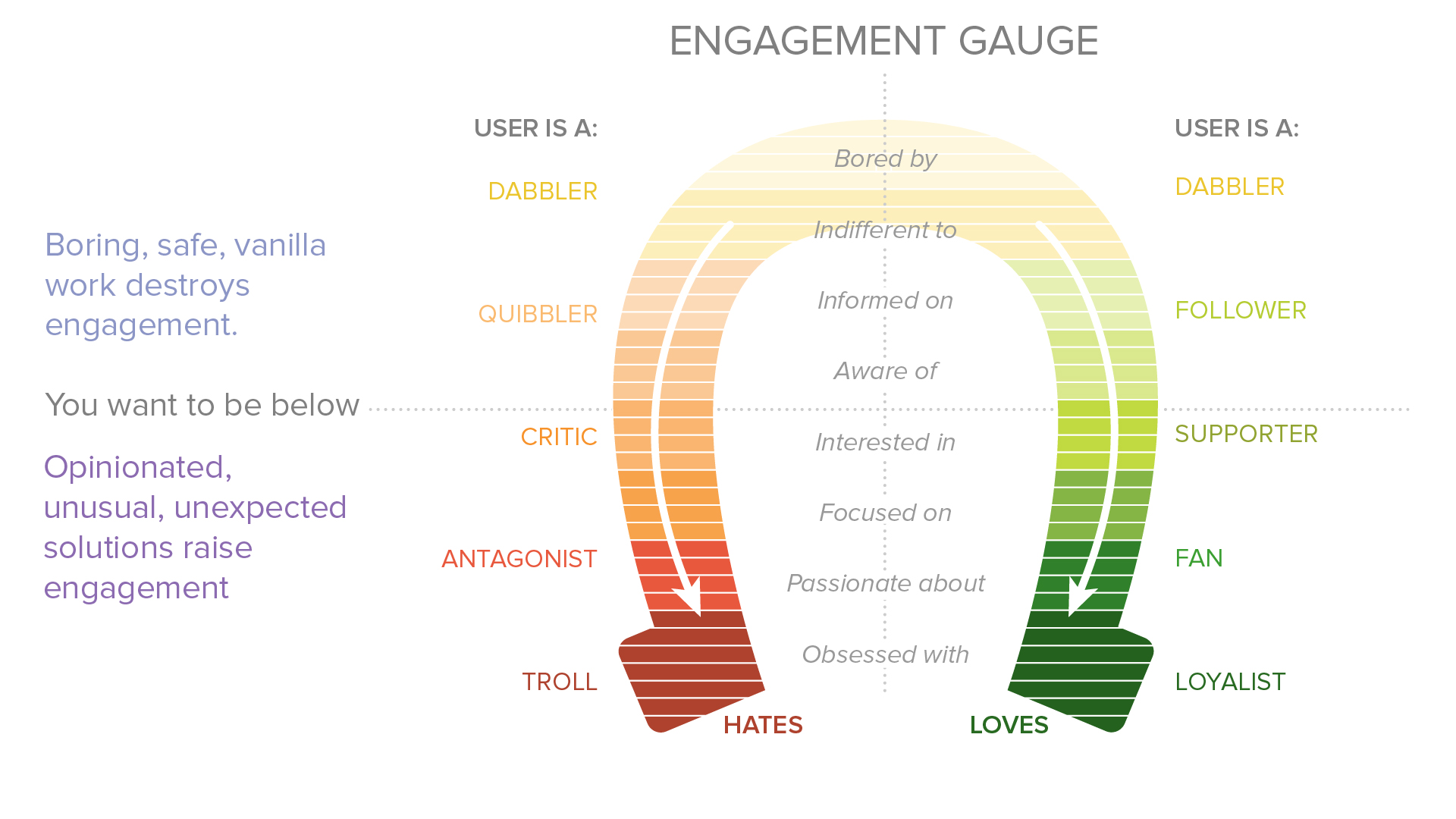See me. Love me. Let me be your bestie. Everyone and every brand has the same goal. We want to be loved by you. And, like the high school experience in America, forming attachments and developing relationships can be confusing, exciting, and dramatic. What starts out as promising interest can quickly devolve into dislike and defriend.
What makes interacting with others so confusing and difficult is our tendency to let the reactions of others guide our choices. If we let our actions be guided entirely by the feedback of others, we lose ourselves and our personality in the process.
Brands, especially, fall prey to paralysis by engagement analysis. “Playing it safe”, “going with the tried and true,” or “being risk-adverse” ensures that no one will ever be unhappy or upset with your product, service or brand. It also means your brand is going nowhere.
At a design & marketing conference years ago I heard a speaker (I can’t remember his name!) use an upside down horseshoe as a metaphor to understand how design works for products and brands. A brand or product with a strong ethos, like Apple, SnapChat, or the PT Cruiser (the originator’s example), generates strong likes and dislikes that result in an increase in sales, while stale, safe commodity brands at the top of the horseshoe sink into oblivion. The horseshoe, which I have redesigned as an Engagement Gauge, depicts this spectrum of user engagement.
- At the top of the horseshoe—safe, boring, ordinary, blasé products and brands.
- At the bottom of the horseshoe—striking, risky, creative, exciting products and brands.
You do not want to be at the top of the horseshoe of engagement. No one cares about what happens there.
The Engagement Gauge
 The more exciting you design your brand, the farther you move down the horseshoe. But, once you move down past indifference, your engagement starts to split into one of two sides—those who love what you are doing and those who hate it. It is the nature of having something to say, that there will be those who agree and those who do not. Being in the marketplace or in the media, where engagement happens, opens us up to every kind of engagement. The more your brand is regarded, the more interest it demands, the more engagement, positive and negative, you will receive.
The more exciting you design your brand, the farther you move down the horseshoe. But, once you move down past indifference, your engagement starts to split into one of two sides—those who love what you are doing and those who hate it. It is the nature of having something to say, that there will be those who agree and those who do not. Being in the marketplace or in the media, where engagement happens, opens us up to every kind of engagement. The more your brand is regarded, the more interest it demands, the more engagement, positive and negative, you will receive.
The level of reaction to your brand design increases as you move down the spectrum. When it increases, so does your media exposure, your engagement scores, KPIs and hopefully your sales. To gain engagement your brand must be designing impressive products, services, media and marketing that engenders interest and focus, that will move you at least halfway down the horseshoe. You want to gain supporters, which means you’ll also start to gain critics. Interest turns into focus based on the strength of your brand’s identity—who you are, what you stand for, what you mean, and how you tell your story. The stronger your story, the clearer you are about what you offer, the more you will turn supporters into fans.
The power of the bottom third
The most successful brands reside in the lower third of the engagement gauge. They have a strong base of fans and a fair share of antagonists, both of whom are passionate about the products and services. Passion means that people are emotionally engaged. We can not gain one without opening our brand up to both. We can’t have one side of the spectrum without the other. Brands will never avoid having detractors. Rather than trying to avoid them, focus on strengthening the ties to those on the green side of the spectrum, doing more of what makes them so loyal. A brand that is grounded in its values can feel confident that the majority of its actions will connect with those who love them. Failing to deliver on those values can flit fans into critics very quickly.
The Engagement Gauge is a helpful visual metaphor for understanding why we need to courage to take risks in product development, marketing and branding. Understanding the parallel yet opposite paths of consumers’ or customers’ reactions helps to prepare us for the inevitable haters that come along as we are celebrating our loyal fans. Despite the risk of gaining detractors, focusing on creating out-of-the-ordinary experiences will give you brand engagement. And when management starts to water down your approach or insist on a safer solution, you can use the engagement gauge to show them why your innovative approach is the path to success.
If you need a creative strategy that will help you move towards the lower third, contact Smart Hive. We create authentic engagement using your brand’s data.




